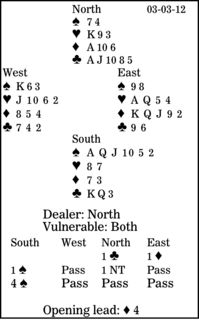Bridge column, March 3: Look at the dummy, then choose a signal

For bridge defenders, a signal is comprehended if partner decodes the message it bespeaks.
How should East signal at trick one in today's deal? South is in four spades. West leads the diamond four, and declarer takes the trick with dummy's ace.
West correctly led low in his partner's suit because he had not supported. To lead high would have guaranteed a singleton or a doubleton. (In contrast, if West had raised to two diamonds, he would have led the eight to deny an honor, East already knowing West had length in the suit.)
Often it would be right for East to signal with the king under dummy's ace to show his touching honors. First, though, East should ask himself where his side will find four winners.
One seems to be the limit in diamonds. There are at least two in hearts if West can be encouraged to shift to that suit when in with his one winner, in either clubs (if he has the king and queen) or spades. (If West has no winner, the contract will be unbeatable.)
To encourage a heart switch, East must discourage in diamonds by playing his two. (An alternative plan is to drop the queen, which would deny the king, because one plays the top of touching honors when one cannot win that trick.)
When West gets in with his spade king, a heart lead should stand out like a tuxedo in a tiki bar.
** ** **
COPYRIGHT: 2012, UNITED FEATURE SYNDICATE
DISTRIBUTED BY UNIVERSAL UCLICK FOR UFS

